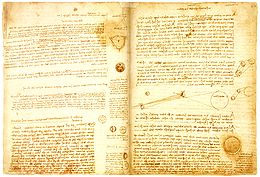 |
| The Codex Leicester |
The manuscript doesn't take the form of a single linear script, but a mixture of Leonardo's observations and theories on astronomy. The main topic of Codex Leicester is the movement water. Among other things, Leonardo wrote about the flow of water in rivers and how it is affected by different obstacles put in its way. From his observations he made recommendations about bridge construction and erosion. Beside that topic, the other topics are the explanation why fossils can be found in mountains and about the moon.
Physically, Codex Leicester takes the form of 18 sheets of paper, which each folded in half and written on both sides. At one time the sheets were bound together, but they are now displayed separately. It was handwritten in Italian by Leonardo, using his characteristic mirror writing and supported by copious drawings and diagrams.
The Codex Leicester was purchased in 1980 by wealthy industrialist and art collector whose name is Armand Hammer. He attempted to rename Codex Leicester became Codex Hammer. The Codex is put on public display once a year in a different city around the world. In 2000, it was displayed at Sydney's Powerhouse Museum. In 2004, it was displayed in the Chateau de Chambord and in 2005 in Tokyo. From June to August 2001, the Codex was the centerpiece of a two-month exhibition hosted by the Chester Beatty Library in Dublin, Ireland.
The Codex was sold to Bill Gates by Christie's auction house on 11 November 1994 in New York. Its price was $30,802,500. After Gates bought the Codex, he had its paged scanned into digital image files, some of which were later distributed as screen saver and wallpaper files on a CD-ROM. A comprehensive CD-ROM version (titled Leonardo da Vinci) was released by Corbis in 1997.
No comments:
Post a Comment